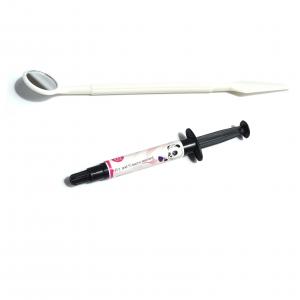

Add to Cart
1.5g Pit And Fissure Sealant For Pediatric Preventive Dentistry
[Structure and composition]
This product is composed of bisphenol A glyceride, triethylene glycol dimethacrylate, hydrophobic nano-silica, tetrabutylammonium tetrafluoroborate, camphorquinone photoinitiation system and colorant; inner packaging Syringes are black polypropylene (plug included). Among them, the purple colorant is titanium dioxide, erythrosin and methylene blue; the pink colorant is titanium dioxide and erythrosin; the blue colorant is titanium dioxide and methylene blue; the white colorant is titanium dioxide.
[Product performance]
It is a viscous liquid before curing, with uniform color and no foreign matter, and it is a milky white solid after curing; the curing time (the time required to be exposed to external energy for complete curing) should not be greater than 40 s; the curing depth should not be less than 1.5 mm.
Product Information:
| Name | Pit And Fissure Sealant |
Package | 1.5g |
| Color | Blue |
Warranty | 3 Years |
| Approved | ISO |
【Instructions】
1. Clean the tooth surface: install a small brush on the low-speed
mobile phone, thoroughly clean the pits and grooves on the tooth
surface that are to be sealed, and then rinse fully with a water
gun. After cleaning the tooth surface, use cotton gauze balls to
prevent moisture, dry the tooth surface and keep it dry.
2. Acid etching, rinsing and drying: It is recommended to use
phosphoric acid gel with a phosphoric acid content of not less than
35% for acid etching. The etching time of permanent teeth is
generally 20-30 seconds, and that of deciduous teeth is 60 seconds.
Be careful not to wipe the etched tooth surface during the etching
process, because this will damage the etched enamel surface and
reduce the bonding force.
3. Apply sealant: Unscrew the sealing cap of the pit and fissure
sealant, install a dental flushing needle or a dental delivery
head, gently push the push rod of the conveyor, and directly apply
the pit and fissure sealant to the pit and fissure. When applying
pit and fissure sealant, attention should be paid to the discharge
of air bubbles, and the coverage of the sealant should be smaller
than that of the acid-etched surface, and it should be as thick as
possible without affecting the occlusion. Sometimes it may be high,
but it can be worn off after 2-3 days. If the coating is too thin,
it will lack sufficient compressive strength and be easily crushed.
4. Curing: After coating, irradiate the pit and fissure sealant
with a light curing machine (lamp) for 20-40 s. The wavelength of
the light curing machine (lamp) should cover 420-480 nm, and the
irradiance (light intensity) should not Less than 1000 mw/cm2,
those with large area should be irradiated in stages. This product
does not flow after curing, and forms a thin, hard milky white film
on the tooth surface, which is easy to observe.
5. Inspection: After the sealant is cured, conduct a comprehensive
inspection with a probe. Check for degree of cure, adhesion,
presence of air bubbles, look for missing or unsealed fissures and
reseal. Observe whether there is too much sealing material and
whether it needs to be removed. If any problem is found, it should
be dealt with in time; check the occlusal relationship, and adjust
the grinding if the sealing agent is too thick.
History:
In the past, several attempts were made to protect pits and
fissures from becoming carious; approaches, such as enamel fissure
eradication, were used. This involved the widening of the fissures,
or so-called fissurotomy, to transform deep fissures into
cleansable ones Another method was to treat pits and fissures with
ammoniacal silver nitrate [13]. None of these approaches, however,
had a great measure of success. A more invasive approach was
introduced by Hyatt in 1923 and this involved the preparation of a
class I cavity that included all deep pits and fissures and the
placement of a prophylactic restoration. In fact, this approach
remained the treatment of choice until the 1970s [14]. In 1955,
Buonocore published his classic study, documenting the method of
bonding of acrylic resin to previously etched dental enamel. He
described the technique of acid etching, using 85% phosphoric acid
for 30 s, as a tool to increase the adhesion of self-curing methyl
methacrylate resin materials to dental enamel. This study was
indeed the beginning of a revolution in dental clinical practice
[15]. In the mid-1960s, Cueto generated the first sealant material,
methyl cyanoacrylate, but it was not marketed. This material,
however, was prone to bacterial disintegration in the oral cavity
over time [16]. Later on, Bowen invented a viscous resin, called
bisphenol-a-glycidyl dimethacrylate, and this has become known as
BIS-GMA [17]. This class was found to be resistant to degradation
and successfully produced a bond with etched enamel. Buonocore made
further advances and published his first paper about pit and
fissure sealant, describing his successful use of BIS-GMA resin
with the use of ultraviolet light in 1970 [18].
Company Profiles:
Chengdu I-ReHealth Medical Devices Co., Ltd is a high-tech R&D and manufacturing company focusing on the oral health field (medical materials and medical devices). Founded in 2016, it is located in the beautiful "Tianfu Kingdom"-Chengdu.
Based on the dental industry, I-ReHealth develops a strategic layout and is committed to providing customers with high-quality oral medical solutions. The company has formed a long-term and in-depth cooperation relationship with the West China Hospital of Stomatology.
FAQ:
1.How can I get the price?
